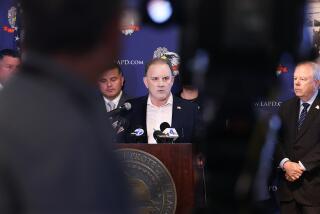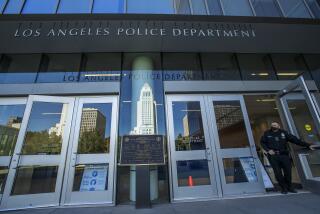Police Feel Heat on Labor Beat
As janitors marched in the drizzle through Warner Center, chanting slogans for higher wages, LAPD Officer Ray Sua hovered in the background, poised to quell any violent outbreak or temper flare-ups.
As is typical, nothing happened: Another loud but peaceful labor protest came to an end.
Sua will be back on the protest beat today, monitoring the janitors as they demand bigger salaries and paid sick days during their march along Ventura Boulevard in Encino.
Every week across the city, officers with the Los Angeles Police Department’s 11-member Labor Relations Section monitor picket lines, rallies and marches in an effort to balance rights to free speech, assembly and public access with those of property owners.
The unit also tries to prevent conflicts between uniformed police and labor at a time when more unions are using boisterous street theater and civil disobedience tactics.
Officers communicate with unions, asking how they can help organize traffic and safety during union actions, said David Stilwell, the Southern California director for the Service Employees International Union, Local 1877, which represents janitors.
“The labor community out there doesn’t move without notifying us--not because they have to, but because they trust us,” said Lt. Charles Helm, who heads the labor detail.
Union leaders say they would rather work with the labor detail than with patrol officers, who are not as well-versed in union rights and who tend to side with management when responding to a confrontation.
“We’re not anybody’s agent,” Helm said. “Our whole role is to be objective. We have the expertise to balance the penal code and the 1st Amendment.”
The relationship between law enforcement and labor, however, is rooted in a contentious past. Problems came to a head in 1990 during a janitors’ protest in Century City.
At that protest, more than 300 striking janitors and their supporters refused a surprise police order to disperse. Riot-helmeted officers attempted to drive them back with clubs; 16 people were arrested, 40 injured.
Police said they decided to halt the march because they had received reports the protesters planned to dump trash at the Century City office towers and disrupt traffic.
“That whole fiasco could have been averted if police had used the labor detail guys,” said David Sickler, the southern regional director for the California Building and Construction Trades Council. Sickler marched with the janitors in 1990 and was jabbed in the back by an officer’s baton, he said.
The labor detail was established in 1969 after lobbying by union officials, Helm said. Until then, only uniformed officers responded to labor disputes, which police handled as crowd control problems, he said.
*
The LAPD’s labor section, which deals with about 320 union locals, is the largest such law enforcement unit in the area. At the Los Angeles County Sheriff’s Department, one sergeant is designated to handle union relations.
Sua, is responsible for relations with 88 unions, including Teamsters who work in the movie industry, schoolteachers, city police and firefighters and sheriff’s deputies.
“We make sure everyone stays within the laws, that [protesters] are able to demonstrate without anyone hassling them, and that we keep them out of management’s hair,” said Sua, a member of the Los Angeles Police Protective League.
Sua acted swiftly during an October shouting match that nearly became a pushing match at a Ralphs supermarket in Los Angeles, where about 150 janitors were protesting, Stilwell said.
“A private security guard came close to hitting [the janitors],” Stilwell said. “Ray Sua stepped in, showed the guy his badge and that backed him off.”
Last year the labor detail monitored 164 union events, Helm said. It also investigates crimes stemming from labor disputes, such as vandalism and assault.
The Los Angeles area is second only to New York when it comes to the number of union locals and members, officials said. Countywide, there are about 800,000 unionized workers and more than 350 union chapters.
The LAPD section expects to be busy this year because about 300,000 workers, including janitors and public school teachers, are scheduled to renew union contracts, Helm said.
Despite the benefits, tensions sometimes arise between unions and labor officers when organizers are asked to provide the unit with sensitive information such as march routes, civil disobedience plans and employer contacts, which union members say hinders their ability to be spontaneous.
Said Stilwell: “You can’t really change tactics too far into it because you’ve given them your word on what’s going to happen and you don’t want to burn them.”
More to Read
Sign up for Essential California
The most important California stories and recommendations in your inbox every morning.
You may occasionally receive promotional content from the Los Angeles Times.









